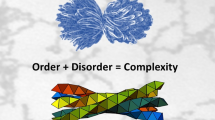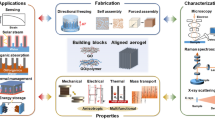Abstract
Fabrication of highly ordered and dense nanofibers assemblies is of key importance for high-performance and multi-functional material and device applications. In this work, we design an experimental approach in silico, where shear flow and solvent evaporation are applied to tune the alignment, overlap of nanofibers, and density of the assemblies. Microscopic dynamics of the process are probed by dissipative particle dynamics simulations, where hydrodynamic and thermal fluctuation effects are fully modeled. We find that microstructural ordering of the assembled nanofibers can be established within a specific range of the Peclet numbers and evaporation rates, while the properties of nanofibers and their interaction are crucial for the local stacking order. The underlying mechanisms are elucidated by considering the competition between hydrodynamic coupling and thermal fluctuation. Based on these understandings, a practical design of flow channels for nanofiber assembly with promising mechanical performance is outlined.
Similar content being viewed by others
References
Behabtu N, Young C C, Tsentalovich D E, et al. Strong, light, multifunctional fibers of carbon nanotubes with ultrahigh conductivity. Science, 2013, 339: 182–186
Zhang M, Wang Y, Huang L, et al. Multifunctional pristine chemically modified graphene films as strong as stainless steel. Adv Mater, 2015, 27: 6708–6713
Egan P, Sinko R, LeDuc P R, et al. The role of mechanics in biological and bio-inspired systems. Nat Commun, 2015, 6: 7418
Gao E, Lu W, Xu Z. Strength loss of carbon nanotube fibers explained in a three-level hierarchical model. Carbon, 2018, 138: 134–142
Launey M E, Buehler M J, Ritchie R O. On the mechanistic origins of toughness in bone. Ann Rev Mater Res, 2010, 40: 25–53
Liu Y, Xie B, Zhang Z, et al. Mechanical properties of graphene papers. J Mech Phys Solids, 2012, 60: 591–605
Lu W, Zu M, Byun J H, et al. State of the art of carbon nanotube fibers: Opportunities and challenges. Adv Mater, 2012, 24: 1805–1833
Zhu H, Zhu S, Jia Z, et al. Anomalous scaling law of strength and toughness of cellulose nanopaper. Proc Natl Acad Sci USA, 2015, 112: 8971–8976
Xie B, Buehler M J, Xu Z. Directed self-assembly of end-functionalized nanofibers: From percolated networks to liquid crystal-like phases. Nanotechnology, 2015, 26: 205602
Lin S, Ryu S, Tokareva O, et al. Predictive modelling-based design and experiments for synthesis and spinning of bioinspired silk fibres. Nat Commun, 2015, 6: 6892
Rising A, Johansson J. Toward spinning artificial spider silk. Nat Chem Biol, 2015, 11: 309–315
Su B, Wu Y, Jiang L. The art of aligning one-dimensional (1D) nanostructures. Chem Soc Rev, 2012, 41: 7832–7856
Xu Z, Gao C. Graphene in macroscopic order: Liquid crystals and wet-spun fibers. Acc Chem Res, 2014, 47: 1267–1276
Hobbie E K, Fry D J. Nonequilibrium phase diagram of sticky nanotube suspensions. Phys Rev Lett, 2006, 97: 036101
Kwon G, Heo Y, Shin K, et al. Electrical percolation networks of carbon nanotubes in a shear flow. Phys Rev E, 2012, 85: 011143
Shim J S, Yun Y H, Rust M J, et al. The precise self-assembly of individual carbon nanotubes using magnetic capturing and fluidic alignment. Nanotechnology, 2009, 20: 325607
Richardson J J, Björnmalm M, Caruso F. Technology-driven layer-by-layer assembly of nanofilms. Science, 2015, 348: aaa2491
Gantenbein S, Masania K, Woigk W, et al. Three-dimensional printing of hierarchical liquid-crystal-polymer structures. Nature, 2018, 561: 226–230
Hausmann M K, Rühs P A, Siqueira G, et al. Dynamics of cellulose nanocrystal alignment during 3D printing. ACS Nano, 2018, 12: 6926–6937
Jeffery G B. The motion of ellipsoidal particles immersed in a viscous fluid. Proc R Soc A-Math Phys Eng Sci, 1922, 102: 161–179
Meirson G, Hrymak A N. Two-dimensional long-flexible fiber simulation in simple shear flow. Polym Compos, 2016, 37: 2425–2433
Dong R Y, Cao B Y. Anomalous orientations of a rigid carbon na-notube in a sheared fluid. Sci Rep, 2015, 4: 6120
Leal L G, Hinch E J. The effect of weak Brownian rotations on particles in shear flow. J Fluid Mech, 1971, 46: 685–703
Sader J E, Pepperell C J, Dunstan D E. Measurement of the optical properties and shape of nanoparticles in solution using Couette flow. ACS Nano, 2008, 2: 334–340
Stover C A, Koch D L, Cohen C. Observations of fibre orientation in simple shear flow of semi-dilute suspensions. J Fluid Mech, 2006, 238: 277–296
Tannous C. Langevin simulations of rod-shaped object alignment by surface flow. Surf Sci, 2011, 605: 923–929
Duggal R, Pasquali M. Dynamics of individual single-walled carbon nanotubes in water by real-time visualization. Phys Rev Lett, 2006, 96: 246104
Pujari S, Rahatekar S S, Gilman J W, et al. Orientation dynamics in multiwalled carbon nanotube dispersions under shear flow. J Chem Phys, 2009, 130: 214903
Brinker C J, Lu Y, Sellinger A, et al. Evaporation-induced self-assembly: Nanostructures made easy. Adv Mater, 1999, 11: 579–585
Marín Á G, Gelderblom H, Lohse D, et al. Order-to-disorder transition in ring-shaped colloidal stains. Phys Rev Lett, 2011, 107: 085502
Marín Á G, Gelderblom H, Lohse D, et al. Rush-hour in evaporating coffee drops. Phys Fluids, 2011, 23: 091111
Bigioni T P, Lin X M, Nguyen T T, et al. Kinetically driven self assembly of highly ordered nanoparticle monolayers. Nat Mater, 2006, 5: 265–270
Narayanan S, Wang J, Lin X M. Dynamical self-assembly of nanocrystal superlattices during colloidal droplet evaporation by in situ small angle X-ray scattering. Phys Rev Lett, 2004, 93: 135503
Lee S G, Kim H, Choi H H, et al. Evaporation-induced self-alignment and transfer of semiconductor nanowires by wrinkled elastomeric templates. Adv Mater, 2013, 25: 2162–2166
Groot R D, Rabone K L. Mesoscopic simulation of cell membrane damage, morphology change and rupture by nonionic surfactants. BioPhys J, 2001, 81: 725–736
Groot R D, Warren P B. Dissipative particle dynamics: Bridging the gap between atomistic and mesoscopic simulation. J Chem Phys, 1997, 107: 4423–4435
Xu Z, Yang Y, Zhu G, et al. Simulating transport of soft matter in micro/nano channel flows with dissipative particle dynamics. Adv Theor Simul, 2018, 4: 1800160
Allen M P, Tildesley D J. Computer Simulation of Liquids. Oxford: Clarendon Press, 1987
Davis V A, Ericson L M, Parra-Vasquez A N G, et al. Phase behavior and rheology of SWNTs in superacids. Macromolecules, 2004, 37: 154–160
Tuckerman M, Berne B J, Martyna G J. Reversible multiple time scale molecular dynamics. J Chem Phys, 1992, 97: 1990–2001
Hobbie E K. Shear rheology of carbon nanotube suspensions. Rheol Acta, 2010, 49: 323–334
Plimpton S. Fast parallel algorithms for short-range molecular dynamics. J Comput Phys, 1995, 117: 1–19
Zhang W, Lin J, Xu W, et al. SCStore: Managing scientific computing packages for hybrid system with containers. Tinshhua Sci Technol, 2017, 22: 675–681
Doi M, Edwards S F. The Theory of Polymer Dynamics. Oxford: Clarendon Press, 1988
Börzsönyi T, Szabó B, Wegner S, et al. Shear-induced alignment and dynamics of elongated granular particles. Phys Rev E, 2012, 86: 051304
Yang X, He P, Gao H. Competing elastic and adhesive interactions govern deformation behaviors of aligned carbon nanotube arrays. Appl Phys Lett, 2012, 101: 053105
Nakajima T. Advanced Fiber Spinning Technology. Cambridge: Woodhead Publishing, 1994
Ko H, Tsukruk V V. Liquid-crystalline processing of highly oriented carbon nanotube arrays for thin-film transistors. Nano Lett, 2006, 6: 1443–1448
Xie D, Lista M, Qiao G G, et al. Shear induced alignment of low aspect ratio gold nanorods in newtonian fluids. J Phys Chem Lett, 2015, 6: 3815–3820
Davis V A, Parra-Vasquez A N G, Green M J, et al. True solutions of single-walled carbon nanotubes for assembly into macroscopic materials. Nat Nanotech, 2009, 4: 830–834
Author information
Authors and Affiliations
Corresponding authors
Additional information
This work was supported by the Opening Project of Applied Mechanics and Structure Safety Key Laboratory of Sichuan Province (Grant No. SZDKF-1601), and the National Natural Science Foundation of China (Grant Nos. 11222217, 11472150). The simulations were performed on the Explorer 100 cluster system of Tsinghua National Laboratory for Information Science and Technology.
Electronic supplementary material
Rights and permissions
About this article
Cite this article
Gao, E., Wang, S., Duan, C. et al. Microstructural ordering of nanofibers in flow-directed assembly. Sci. China Technol. Sci. 62, 1545–1554 (2019). https://doi.org/10.1007/s11431-018-9421-5
Received:
Accepted:
Published:
Issue Date:
DOI: https://doi.org/10.1007/s11431-018-9421-5





